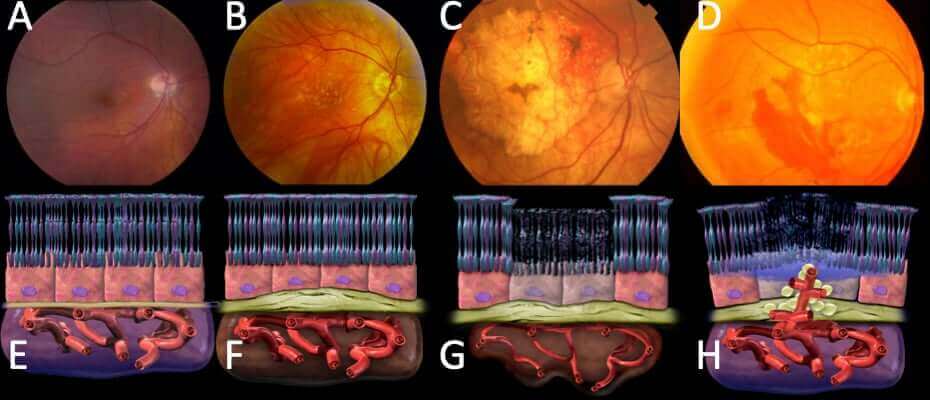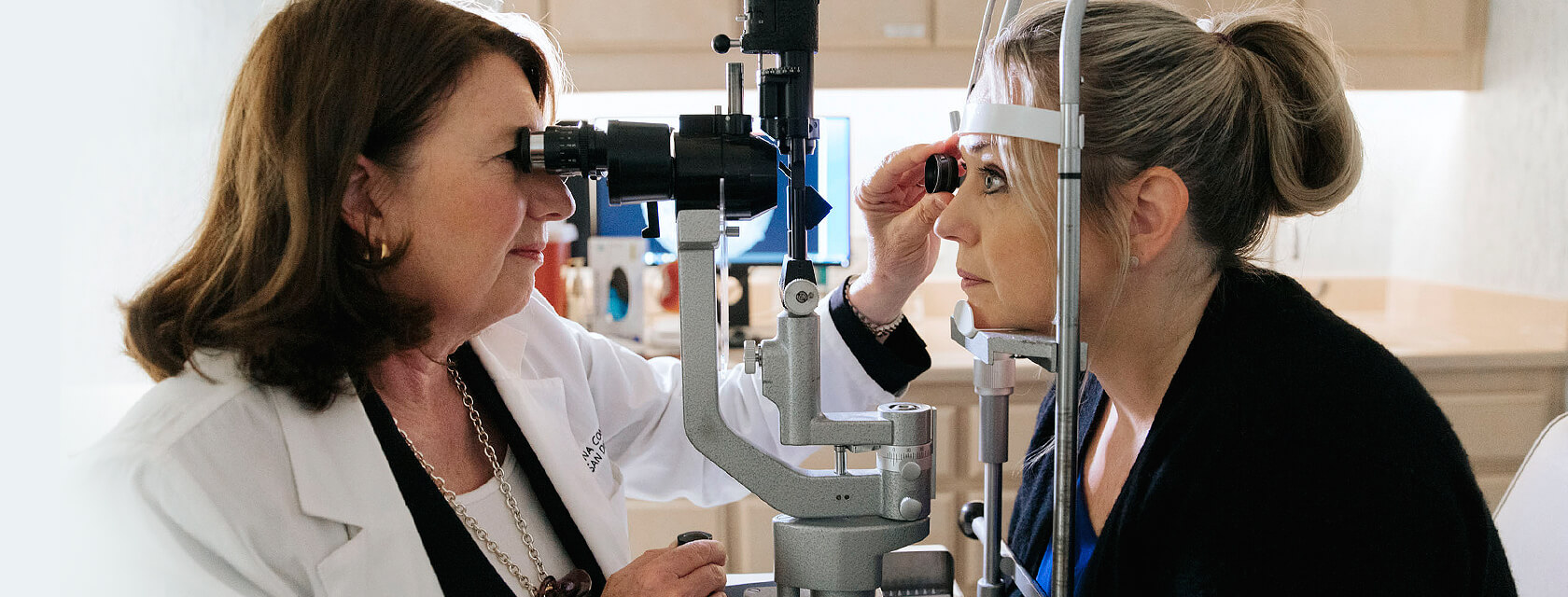Before getting started, read our Retina 101 page.
What is age-related macular degeneration?
Age-related macular degeneration (AMD) is a degenerative disease of the retina that can result in central vision loss and blindness. The leading cause of irreversible impairment of vision in people over 50 years of age, AMD is one of the most common diseases we treat.
AMD occurs in two forms, non-neovascular (dry) AMD and neovascular (wet) AMD. Dry AMD is defined by the presence of drusen and/or pigmentary changes in the macula. Drusen are small, yellow, subretinal deposits of a material called lipofuscin, which is similar in composition to cholesterol. In general, dry AMD is relatively benign, but patients may notice difficulty with contrast sensitivity as well as difficulty seeing in low-light situations.
There is an advanced form of dry AMD called geographic atrophy where the tissue layer directly beneath the retina becomes atrophic and dysfunctional, causing a blind spot in the affected area. While central geographic atrophy is relatively uncommon, significant visual dysfunction can result. However, there is good news, as the FDA has approved the first and only geographic atrophy treatment, shown to safely and effectively slow its progression.
Much more notorious, wet AMD is defined by the development of new, weed-like, blood vessels underneath the retina. These blood vessels are irregular, leak fluid, and can bleed fairly easily.
![Varying stages of dry and wet age-related macular degeneration [AMD].](https://www.rcsd.com/media/pages/retina-conditions/age-related-macular-degeneration/732f507f0c-1679682687/rcsd-figures.006.jpeg)
AMD Symtoms
Drusen do not cause visual loss unless they are large, but their presence may be associated with difficulty with dark adaptation and poor contrast sensitivity. The size and distribution of drusen correlate with the risk of developing wet AMD and/or geographic atrophy.
Additional Findings
Dry macular degeneration is defined by the presence of drusen, seen as yellowish deposits in the macula (figure 6). These are common, seen in about 25% of all people over the age of 70, and are composed of material similar to that in atherosclerotic plaques. Geographic atrophy is seen as well-defined, flat areas of loss of pigmentation. Wet AMD is associated with swelling and, less commonly, bleeding.

AMD Treatment
All patients with AMD are advised to not smoke, to live a healthy lifestyle, including regular exercise, follow a Mediterranean diet, and monitor the vision in each eye closely with an Amsler grid. Patients with drusen only typically do not require treatment. Patients with large, soft drusen are advised to take an AREDS 2 vitamin, which is a combination of high-dose antioxidants and carotenoids.
Regarding geographic atrophy, the FDA has approved Syfovre™ (pegcetacoplan injection), as the first and only treatment option. This injectable medication has been found to safely and effectively slow lesion growth, with its effects increasing over time. Additionally, stem cell therapy is being developed to repopulate damaged RPE cells. While promising and very exciting, stem cell research is still in very early stages, and not available to most patients.
Wet AMD is treated with injections of medicine into the affected eye(s) that inhibit the growth of the abnormal blood vessels. We go to great lengths to minimize any discomfort. Patients with vision loss from AMD may benefit from a low vision evaluation, magnifiers, special lights, and digital assistance devices.
Several exciting new treatment options are being evaluated in various stages of clinical trials.
Outcomes
Most patients do well, and we will do our absolute best to preserve your sight for the rest of your life. Dry AMD patients without geographic atrophy typically do very well with no treatment. Patients with geographic atrophy can have excellent vision unless the atrophy involves the fovea. The area of atrophy enlarges very slowly over years, and we often have clinical trials evaluating medications to slow this down even further. However, the approval of Syfovre™ offers patients a safe, effective treatment option, with its effects increasing over time.
Patients with wet AMD can do very well, especially when diagnosed early with minimal vision loss. While regular injections are needed to maintain vision, improved, next-generation, medications with better potency and longer durations of action are being developed, and may be available to you in clinical trials.

